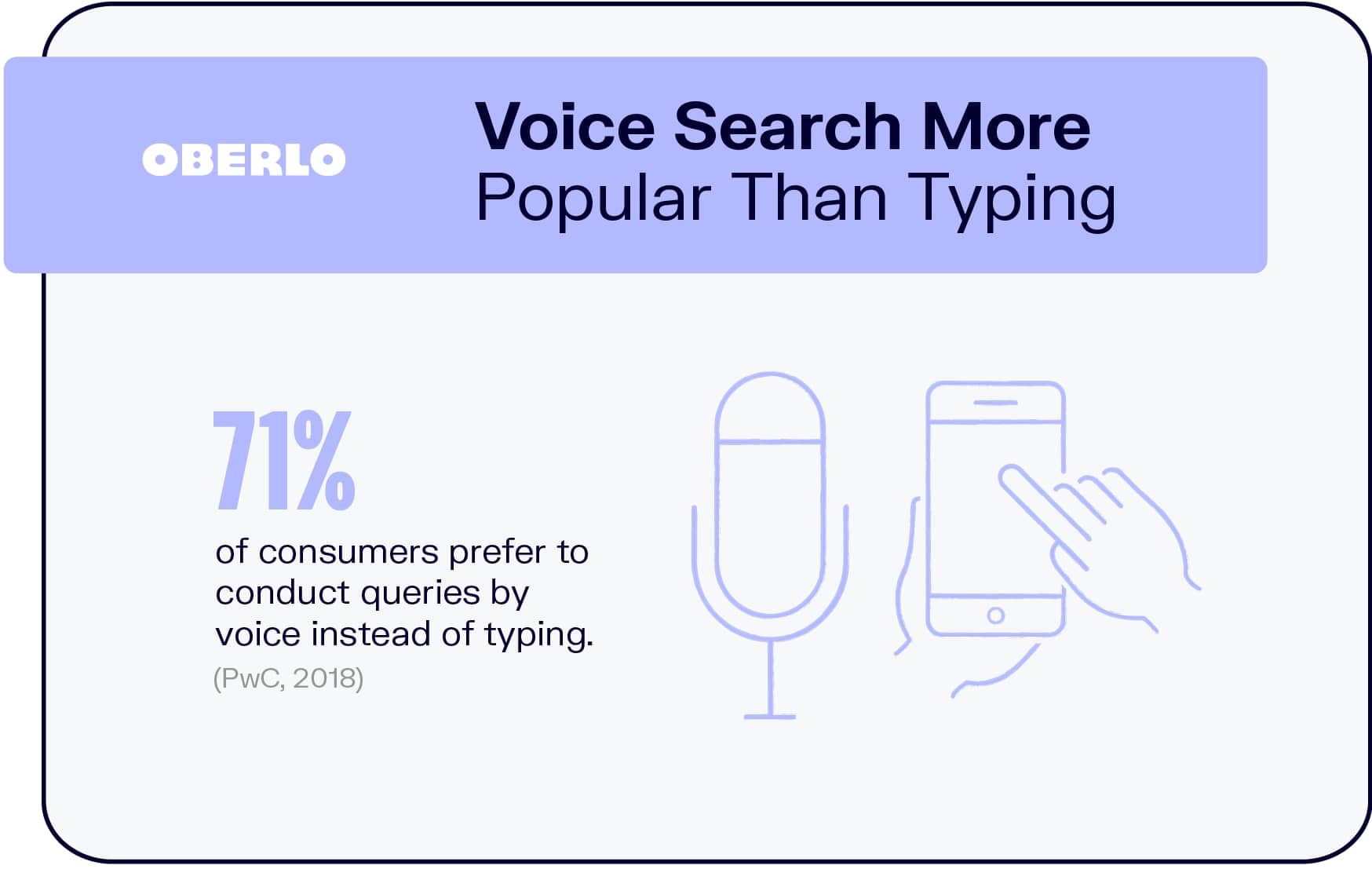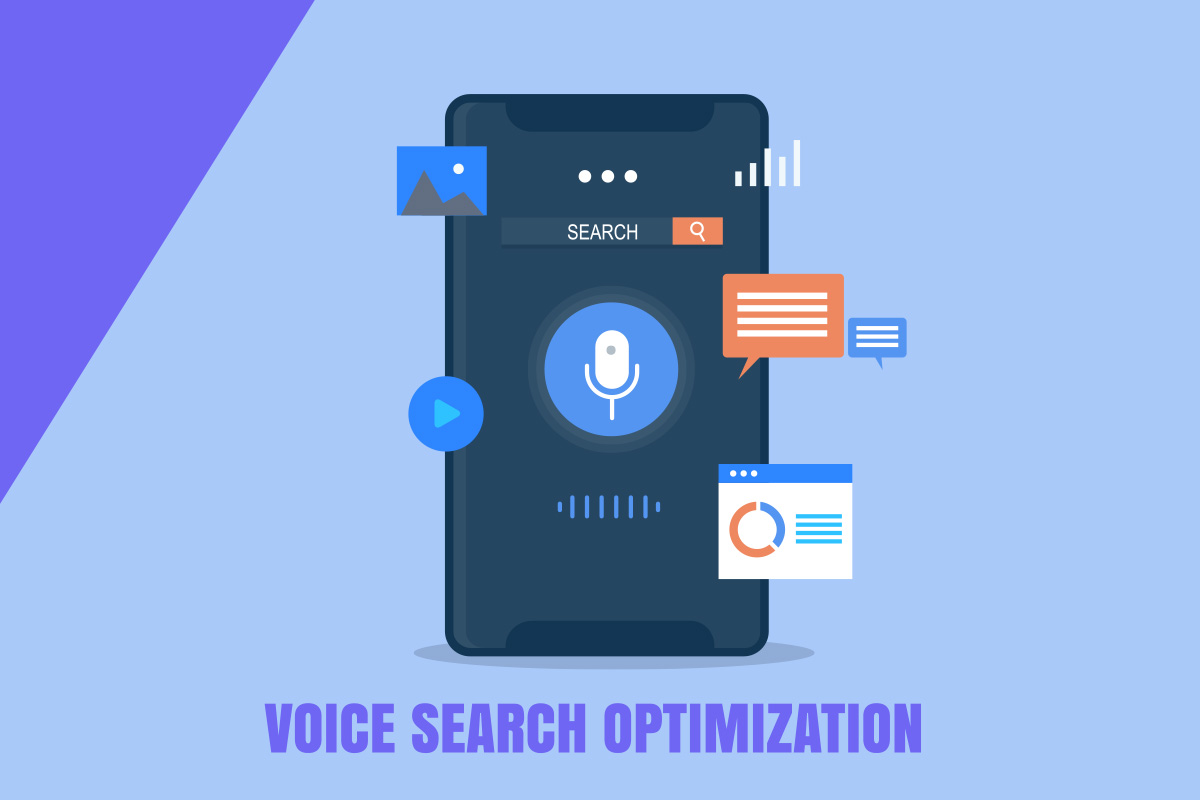28 min to read
Voice Search Optimization: A complete guide in 2024 (Updated)
Voice Search Optimization
As voice search grows more popular, it's important to make sure your website is optimized for this type of search.
This post will show you how to optimize your website for voice search. We'll cover the basics of what you need to know and all the tips to help you get started.
CodeDesign is a leading digital marketing agency ranked #1 in Lisbon, Portugal.
What is voice search optimization?
Voice search optimization is the process of upgrading and streamlining the information on your pages to appear in voice searches. Voice search optimization aims to optimize your page to answer the questions for people when they conduct verbal searches. This process allows you to have a chance to get your page read by the voice search device(Alexa, Siri, OkGoogle) whenever the user asks for information related to your page.
And 66.3 million U.S. households are forecasted to own a smart speaker in 2022.
Statistics on Voice Searches that is sufficient to convince anyone on why is voice search optimization so crucial:

Credits for the image: OBERLO
- 58% of consumers use voice search to find information about a local business online. (Source: Search Engine Journal)
- 27% of the online Google population is using voice search on mobile(Source: Google)
- 52% of smart speaker owners keep their devices in a common space such as a living room. 25% of people kept their device in the bedroom, while 22% kept the speaker in the kitchen. (Google)
- 75% of voice search results rank in the top three positions for a particular question on a desktop search
- 60% of people claim that smart devices are essential to their lives, and they can't imagine going back
- 25% of Windows 10 desktop searches were made by voice
- 56% of voice searches were performed to look for something up on the internet.
The Importance of Voice Search
It's no secret that voice search is on the rise. In fact, 58% of consumers use voice search to find information about a local business online. (Source: Search Engine Journal). That's a pretty big number, and that's why it's so important to start optimizing your website for voice search today.
So, what can you do to make your website more voice search friendly? Here are a few tips:
1. Make sure your website is mobile-friendly. More and more people are using voice search on their mobile devices, so it's essential that your website is responsive and easy to navigate on smaller screens.
2. Use long-tail keywords in your content. Voice search is particularly good at answering specific questions, so using long-tail keywords will help you target those queries.
3. Make sure your content is accurate and up-to-date. One of the main complaints about voice search is that results can often be inaccurate. To avoid this, make sure your website's content is accurate and up-to-date.
How does automatic speech recognition system work?
The automatic speech recognition system (ASR) is a technology that converts voice impulses into text for the purpose of voice search. This allows users of smart devices, such as smartphones, smart speakers, and cars, to perform voice searches using voice recognition technologies. The voice search engine converts the spoken words into text and analyzes it in the same way as a traditional search query, presenting relevant search results. Machine learning and artificial intelligence (AI) are constantly improving the accuracy and efficiency of voice search by better understanding human language and the searcher's intent. AI also helps to enhance audio quality and extend battery life for personal voice assistants. As a result, voice search systems are now able to more accurately understand and respond to requests and instructions given by users.
Basically, the process is as follows:
ASR software detects speech when an individual or group speaks. The device then records the words it hears in a wave file. The wave file is treated to adjust volume and remove ambience.
The sequences of this filtered wave pattern are then broken down and looked at.
The automatic voice recognition software analyses these sequences and then using statistical likelihood to recognise the individual words before going on to whole sentences.
Voice search and its evolution
As voice search gains momentum in the era of smart gadgets and advancing AI capabilities, its potential lies in deciphering the subtleties of natural language and delivering answers with context. This evolution encompasses not just understanding spoken words but also grasping the intent behind them. Through spelling clarifications, past interactions, refined queries, pinpoint location accuracy, and seamless app integration, AI is propelling voice search to new horizons, offering tailored responses that cater meticulously to user needs.
Building on Prior Conversations
For example, if you ask "What's the weather like today?" followed by "And what about tomorrow?" and "Should I bring an umbrella?" The AI intelligently connects the dots from your initial question, providing a fluid experience. Furthermore, if the initial search doesn't yield precise results, providing additional context can fine-tune the outcome.
Contextualising to Location-Based Nuances
On the other hand, let's say you asked "How far is the museum from here?" The AI intuitively comprehends your current location, tailoring the answer to your specific context. This personalised touch in search outcomes enriches your search adventure.
App-Integrated Intelligence
Let’s say you are in a conversation within a travel app, talking about your upcoming trip to Tokyo. You mention the phrase "Sushi restaurants," discussing your intention to explore the best places to enjoy authentic Japanese cuisine. Now, envision saying, "Show me the top-rated ones." Remarkably, the AI seamlessly identifies that your previous context is about dining in Tokyo and understands your request. It proceeds to retrieve and present a list of the highest-rated sushi restaurants in the city, eliminating the need for you to specify the location explicitly.
In this scenario, AI's ability to grasp the ongoing conversation within an app and interpret your subsequent query in the same context elevates your search experience. By recognizing the app-specific context and understanding your intent, AI minimises the effort required to find the information you're seeking. This integration between your conversation and the app's content streamlines the process of retrieving relevant details.
Voice Search Vs Text Search
Voice search is a type of search that is performed using voice commands or spoken phrases rather than typed keywords. When you use voice search, you can ask a question or make a request using natural language, just like you would when speaking to another person. This contrasts to text search, where you type keywords or phrases into a search box to find information.
Voice search differs from text search for several reasons, including the conversational nature of voice search queries and the use of spoken language. Voice search queries tend to be longer and more descriptive and may include words or phrases that are not commonly used in text searches. Voice searches are also often conducted in a specific context, such as when a user is driving or performing a task around the house. The results must be relevant to the user's location, situation, or needs. To optimize for voice search, it is important to create content relevant to the user's query, uses natural language, and considers the user's context and personalization. Although voice search tends to use complete sentences, it is also specialized.
When speaking to a digital assistant, people tend to be more concise and specific with their requests, possibly because a more concise question results in a more precise response. Enabling a user's location can provide accurate results for searches such as "Find an Italian restaurant nearby." As a result, business owners should tailor their websites and content to accommodate simple but precise searches. To achieve this, it may be useful to create a thorough FAQ page or a blog with authoritative material written around long-tail keywords and specific but general questions. To do this effectively, it is important to research the types of questions that your target audience commonly asks digital assistants and create content that addresses those issues.
|
Aspect |
Voice Search |
Text Search |
|
Query Style |
More conversational, similar to natural speech |
Often concise and fragmented |
|
Query Examples |
"What's the weather like today?" |
"Weather forecast today" |
|
Length of Queries |
Longer and more descriptive |
Shorter and to the point |
|
Searcher Behavior |
Often seeks immediate answers or actions |
Can be exploratory or specific |
|
User Intent |
Frequently seeks direct information |
May require interpretation of context |
|
Algorithm Emphasis |
Focus on understanding context and intent |
Prioritizes matching keywords |
|
Search Engine Response |
Provides concise, relevant answers |
Offers a list of results for further exploration |
|
User Interaction |
More interactive and conversational |
Mostly involves clicking and scanning |
|
Context Awareness |
Can understand previous questions' context |
Lacks context awareness in the same session |
|
Technology Requirement |
Relies on voice-enabled devices and apps |
Compatible with most devices and platforms |
|
Privacy Concerns |
Involves voice data storage and processing |
Typically involves text-based data storage |
How to do voice search optimization?

Voice Search Optimization Tricks
Keyword Research as a part of voice search optimization
Google relies heavily on featured snippets and knowledge graphs to answer to voice queries of people. As the intent behind voice search is to get quick and immediate results, voice search devices try to give instant results with the help of rich snippets and knowledge graphs. Having a high domain rating is also crucial.
Now, what is the featured snippet?

Google Featured Snippet
Features snippets are short answers to the user's question and are extracted by Google from pages already ranked on the first page to give a brief description(about the query) and enhance user experience. Rich snippets are positioned above the organic results, and they could be in the form of paragraphs, tables, numbers, bullets, charts, graphs, images, YouTube videos, carousels, etc.
If your page is optimized for featured snippets, it is a clear indication that your web page answers the user's question. According to the reports, featured snippets get around an 8% click-through rate. Hence there is a chance of a high CTR. Read the differences between digital marketing vs traditional marketing.
What is a knowledge graph?

Google Knowledge Graph
The Google knowledge graph is a humongous database of information that allows Google to provide the quick and right information to the user's queries. The data for the knowledge graph is collected from various sources, be it publicly accessible or privately licensed.
As the knowledge graph can answer most of the queries, Google always looks at the pre-existing knowledge graph to answer the voice searches, which, however, reduces the organic click-through rate.
12 Strategies for voice search optimization:
1. Voice search queries have question words. Hence, use question keywords and long tail keywords
2. Use Schema Markup to improve the relevance of your content
3. Having an FAQ section would provide an immediate and short description as the answer to their question
4. Create detailed and informative content with your customer persona in mind
5. Ensure that your website loads fast
6. Your website has to be mobile friendly
7. Optimize your website with local SEO techniques to rank for "Near Me" voice queries
8. Multilingual SEO for Voice Search
9. Improve Your Micro-data
10. Try to write in conversational tone
11. Build FAQ pages
12. Ensure that you've claimed your Google My Business profile
1. Question Keywords and long-tail keywords are necessary for voice search optimization.

Keyword Research for Voice Search Optimization
If you notice on a general level, people tend to ask the entire question when using voice search devices instead of just putting the short-tail keywords. For example, you would ask, "Hi Alexa! (or Hey SIRI, or Ok Google!), how do I optimize my website for search engine optimization with the help of an SEO agency". On the other hand, if you had to type the same thing, you might have targeted the short tail keyword like SEO agency, website SEO optimization, etc. The main point behind the difference is that when people type, they have to take a larger amount of pain and spend a longer amount of time searching for the complete query. Thus, they prefer to go with the short tail keywords and see what Google has to offer.
On the other hand, voice searches have made it easier for people to search their long questions without spending much time and energy. Voice search devices are very accurate now to analyze the user's question, and maybe this is why 60% of people never want to go back to the old time of typing the entire thing.
Voice search queries generally have many question words. Thus you should add keywords like how, what, where, when, why, etc., to make your content more relevant for voice search. As discussed above, long-tail keywords make more sense for voice searches. Hence, for no good reason in this world, you could ignore long-tail variations of the keywords.
The average Google voice search result is at ninth-grade level (Source: Backlinko), which means all the fancy vocabulary and difficult words may harm your chance to appear in voice search results. Instead, you could use this opportunity and put conversational content that will resemble the language people use while using voice assistants. You could use filler words like "I, the, of the, on the, to, for, a, me," etc.
2. Use schema markup to provide context to your content.

Schema markup is the structured data markup
Schema is the structured data markup that helps the search engines to make sense of your content. Schema markup has a great influence on SEO, mainly rich snippets. The purpose of schema markup is to make your site discoverable by search engines as they give a complete picture of what your content is all about and your intent.
When you adopt schema markup for your voice search strategy, you are simply helping the search engines with an indicator of intent and relevancy.
3. Ensure that you have an FAQ section

FAQ section is crucial for voice search optimization
Most voice searchers begin their search with a question that starts with "Who, What, Why, How, When, etc." It means they need an immediate and short description as the answer to their question. You could use the FAQ section on your pages that gives attention to all the related questions to your target keyword that the searcher may have.
You must answer all these questions in a conversational tone to appeal to the voice search. Your website and web page must be technically sound and include schema markup to help search engines better understand the content. You must make sure that the navigation and informational structure is easy to find and your page loads at a good speed.
4. Know your customer persona and create the right type of content for your persona

Customer persona
Conciseness, ambience, and relevance are crucial for your voice search strategy. The way a millennial would use voice search is different from a Gen Z or Gen Alpha. Thus, create a customer persona and use it to dig deeper into the content you create to help your persona with the most relevant information. You could create a webpage with a headline that covers the most common question.
Next, you could provide a detailed answer or definition to the keyword. After this stage, you could elaborate details on the topic to solve every pain point of the searcher. Also, focus on the digital marketing funnel while creating the content.
5. Ensure that your website loads fast

Fast loading speed is crucial
Website loading speed is a crucial factor for SEO and voice search. It directly impacts the bounce rate and needs to be optimized as soon as possible. When you notice the purpose behind voice search, you realize that the searcher needs quick answers.
On the contrary, if you have a slow website that takes gazillions of years to load, no search engine would use them for answering the questions. Hence the entire purpose and optimization process fails if your website is not updated and loads fast.
6. A mobile-friendly website is crucial for your voice search optimization strategy.
The mobile experience is crucial for the growth of your website in terms of SEO and voice search optimization. In 2019, Google announced how mobile experience directly impacts your website ranking. This update was made with an eye on how the mobile users increased significantly. It is often suggested to have a mobile-first approach:
Have a responsive website. Make sure that your website passes the mobile-friendly test. Also, your website should be crawlable by Google spiders.
7. Perform local search optimization to rank for keywords relevant to your business in a given location and appear for "Near Me" queries.

Local SEO for voice search optimization
Local SEO is the process by which you optimize your website to appear for local search results. It is crucial for any business with offices in a specific location or to appear for searches made in a particular area. You would be amazed to know that 46% of searches performed on Google are meant for local queries.
In terms of voice search optimization, local SEO is crucial because if you perform a "Near Me" voice search regarding any business, voice search devices like Siri, Alexa, etc., would read out the names of the listing chronologically.
8. Multilingual SEO for Voice Search
Did you know that Google can recognize about 120 different languages for voice search? While this is great for user experience, it can make ranking highly challenging, especially if your site receives visitors from all over the world. In this case, focusing on multilingual SEO and paying special attention to voice search is essential.
Keep in mind that people tend to use voice search in their native language, making multilingual SEO especially important. If you do not optimize for multiple languages, visitors searching in their native tongue will not be able to access your website.
Hreflang annotations are crucial for websites that support multiple languages. These annotations allow Google and other search engines to determine which version of a website to show to specific users based on their language preference. For example, hreflang enables Spanish users to view the Spanish version of a website and English speakers to view the English version. It is also recommended to use the "alternate" attribute in conjunction with hreflang to inform Google that the page is a translation rather than a duplicate of another webpage. This helps prevent issues with duplicate content.
9. Improve Your Microdata
To make your website more easily crawlable and understandable for Google, it's important to submit your Google My Business information and create a sitemap that includes details such as the prices of your products, directions to your location, your store's operating hours, and your contact information. You can also use microdata to help Google understand your content better. Add markups for different usage scenarios to enhance your website's microdata. By doing these things, you increase the chances that Google will use your website's content to answer voice search queries.
10. Try to write in conversational tone
Voice searches are like conversations. That's why it's a great idea to give your content a conversational feel to connect with users. Not only does this make your content feel genuine and easier to understand, but a less formal writing style is also seen as more relevant for voice queries.
There are a few ways to infuse a conversational tone into your content. In blog posts, try using more everyday words (like "I," "you," "we") and avoid using complicated jargon or overly technical terms. Sprinkle in a touch of humour here and there to support your main points. If your brand has a particular voice, aim for a more relaxed version of it when writing.
This doesn't mean lowering the quality of your content. You should maintain a casual writing style while ensuring your content is engaging and helpful to readers. Google still values well-crafted content — just write it as if you were speaking it out loud.
11. Build FAQ pages
When individuals use voice search, they usually start their questions with words like "Who," "What," "Where," "When," "Why," and "How." Their aim is to find quick answers that address their immediate requirements. To effectively address these queries, create a Frequently Asked Questions (FAQ) page and initiate each question with these adverbs.
Then, provide conversational answers to align with voice search preferences. From a performance standpoint, ensure your website is technically robust and incorporates schemas. Make sure that navigation and the arrangement of information are user-friendly, while also ensuring swift page loading speeds.
12. Ensure that you've claimed your Google My Business profile
About half of voice search users engage in daily searches for local business details. Given voice search's strong local focus, ensuring your business search results appear at the top is crucial. Hence, it becomes an important step to claim your Google My Business profile. And, our experts at CodeDesign could help you with this as well.
This step is an absolute necessity for all brick-and-mortar enterprises, regardless of voice search. The process is simple and completely free. Craft your listing, furnish it with comprehensive information, and await approval.
Best Practices for Voice Search Optimization
Now that you know the basics of voice search optimization, it's time to put that knowledge into practice. Here are a few best practices to help you get started:
1. Make sure your website is mobile-friendly. Most voice searches are conducted on mobile devices, so your website needs to be optimized for mobile users.
2. Optimize your content for question-based keywords. When creating content, try to use keywords that people are likely to ask in a voice search.
3. Use natural language in your content. When writing website copy, use the same language that people would use in a normal conversation. This will make it easier for search engines to understand your content and rank it higher in the results pages.
4. Increase the frequency of your backlinks. Backlinks are still an important factor in SEO, so make sure you're including links to your website from other authoritative sources.
5. Use structured data markup on your website. This will help search engines better understand the content on your website and return more accurate results when users conduct a voice search.
6. Use short, concise titles and descriptions. When people use voice search, they typically only say a few words at a time. Make sure your website's titles and descriptions are easy to understand and relevant to your target audience.
Google’s BERT Algorithm: How it relates to Google’s focus on voice search optimization
Many SEO experts, marketers, and specialists believe that Google's BERT algorithm will have a significant impact on search engine marketing and voice searches. BERT stands for "Bidirectional Encoder Representations from Transformers," and it uses machine learning and Natural Language Processing (NLP) to better understand the context of search queries. Google refers to it as "State-of-the-Art Pre-training for Natural Language Processing," and its goal is to improve the search experience for users and to require businesses to adapt their search engine strategies to the algorithm.
It is particularly effective at handling more complex or conversational search queries, as it is able to consider the relationships between words in a sentence and understand the intent behind the search. This enables BERT to provide more accurate and relevant search results, helping users find the information they are looking for more easily. As more people use voice assistants like Google Assistant to search for information, Google needs to be able to understand the context and meaning of spoken search queries in order to provide accurate and useful results. BERT is important because it can understand the meaning behind a search question and consider the connections between words in a sentence, which helps improve the accuracy and relevance of voice search results.
Is voice optimization important for local businesses?
Yes, voice optimization is very important for local businesses. Voice optimization helps businesses appear in voice search results, which is an increasingly important way for customers to find local businesses. For example, voice search is used by many customers to find nearby businesses, making it critical for local businesses to appear in the results.
Voice optimization can also help businesses build brand recognition, create better customer experiences, and increase their visibility in local search results. Optimizing content for voice search can also boost a business’s credibility and trustworthiness, as customers are more likely to trust a business that appears in voice search results than a business that does not. Additionally, voice optimization can help businesses reach customers more quickly and easily, as voice search results are often faster and easier to access than traditional search results. With the growing popularity of voice search, local businesses should make sure to optimize their content for voice search to stay competitive.
But you're looking to stay ahead of the curve and ensure your website is up to date with the latest voice search technology, then you've come to the right place.

Voice optimization and its importance for people with disabilities?
Voice optimization is an important technology for people with disabilities. It helps them to communicate more easily and accurately and can even improve the quality of their lives. For people with disabilities, communication can be a challenge. They may have difficulty speaking due to physical impairments or neurological conditions. In some cases, they may be completely non-verbal. This can make it difficult for them to communicate their needs, or even to interact with other people. Tech can help to bridge the gap. It uses artificial intelligence (AI) and natural language processing (NLP) to recognize the user’s voice and understand what they’re saying. It can then convert the user’s speech into text, allowing them to communicate more effectively. That's pretty awesome.
This optimization can help improve the quality of life for people with disabilities. For example, it can be used to control devices such as computers. This allows people with physical impairments to stay safe and independent. It can also be used to access educational resources, helping those with learning difficulties to learn more effectively.
I know that we are focusing on performance, and targeting bigger groups, but it can make a real difference to the lives of people with disabilities. It can provide them with independence and autonomy, and help them to communicate more effectively. It’s an important technology that is changing the lives of many people with disabilities, and it’s set to become even more important in the future.
Test if your website is compliant with disability rules.
The best way to test if your website is compliant with disability rules is to use automated tools such as accessibility checkers. These tools will check for a range of criteria and provide a report on any issues that need to be addressed. Additionally, you can find organizations that offer manual testing of websites for WCAG compliance.
If your website is to be accessible to users with disabilities, it is important to ensure it meets the standards set out in the Web Content Accessibility Guidelines (WCAG). To test if your website is compliant, you can use automated tools such as accessibility checkers. These tools will examine your website against a range of criteria and provide a report on any issues that need to be addressed. For example, voice search technology is becoming increasingly popular, so it is important to make sure your website is accessible for voice search. Automated tools can check for voice search compliance and provide a report on any potential issues.
In addition to automated tools, organizations such as Accessible360 offer manual checks for WCAG compliance. Their experienced accessibility professionals can review your website and provide a detailed report on any issues that need to be addressed. This service is valuable as it can detect issues that automated tools cannot detect.
Ultimately, testing your website for WCAG compliance is essential to ensure it is accessible to all users. Automated tools and manual checks can provide valuable insights into any issues that need to be addressed. By ensuring your website meets the standards set out in the WCAG, you can make sure it is accessible to everyone.
Varied Applications of Voice Search
Wearable Tech: Real-Time Assistance Voice Queries
Wearable devices like smartwatches are becoming the go-to source for immediate assistance.
Imagine a busy executive rushing from one meeting to another. Suddenly, they need a quick translation for an important phrase during a phone call with someone from another country. With just a fast voice search on their smartwatch, they can quickly find the translation and keep up with their work effectively.
Tablets: Casual Voice Queries
Individuals seeking rapid answers or quick solutions frequently resort to voice searches on their tablets.
Let’s talk about an example when you suddenly get intrigued about which countries border the Mediterranean Sea. A swift voice search could provide the answer without interrupting your relaxation.
Connected Cars: Travel-Related Voice Queries
When people set off on road trips in their cars, they use voice search through the car's infotainment systems. They can ask for help finding rest stops, beautiful places to see, or good restaurants nearby with great reviews. This kind of voice search helps them have a better and more enjoyable journey.
Some widely accepted voice search devices and search engines they use
Google Home: Equipped with Google Search
Amazon Echo/Alexa: Linked to Bing
Google Assistant: Powered by Google Search
iPhone/Siri: Utilises Safari and other sources
Android phones and devices: Tied to Google Search
Microsoft Cortana: Utilises Bing
How will Generative AI impact voice search?
Bard or ChatGPT can assist in answering queries during a search, which could lead to lesser clicks to your website. It could be compared to Google's attempt to provide a better user experience and more information through its Knowledge Graph. And, just like the increase in adoption rate for virtual assistants like Alexa and Siri, these AI assistants could surely steal clicks.
Now, when Google’s Bard and Bing’s AI bot can easily process information and serve it to the audience, there could be a speculation that voice assistants will use this information to serve you answers. Will it mean lesser clicks? Of Course it could and there is a huge debate in the industry on how it will impact the entire SEO overall.
According to Sundar Pichai, Alphabet's CEO, AI-powered search features will soon distil complex information and multiple perspectives into easy-to-digest formats. After Bard's answer, there is usually a list of articles that complement the solution, which provides more opportunities to get traffic.
Generative AI, a groundbreaking advancement in the field of artificial intelligence, is revolutionising the landscape of voice search, a key area of interest for digital marketing strategists at Codedesign. This technology, leveraging algorithms like GPT (Generative Pre-trained Transformer), is significantly enhancing the user experience in voice search, making it more intuitive and accurate. This transformation is not just a technological leap; it's a paradigm shift in how users interact with digital platforms, impacting businesses and marketing strategies profoundly.
Firstly, the integration of Generative AI into voice search has substantially improved the accuracy of voice recognition. Traditional voice recognition systems often struggled with understanding diverse accents and dialects. However, AI models, trained on extensive datasets, have become adept at comprehending a wide range of speech patterns. This improvement is crucial for businesses as it broadens their reach, allowing them to effectively cater to a more diverse audience. For instance, at Codedesign, we've noted a significant uptick in the success rate of voice-activated searches across our client's platforms, directly correlating to enhanced customer satisfaction and engagement.
Generative AI has brought a level of personalisation to voice search that was previously unattainable. By analyzing user data and search history, AI can tailor search results to individual preferences, enhancing the relevance and efficiency of the search experience. This is not just a convenience for users; it's a goldmine for businesses. By understanding user preferences, companies can deliver targeted advertising and content, significantly increasing the chances of conversion. For example, a Codedesign client in the retail sector experienced a 30% increase in click-through rates after implementing AI-driven personalized voice search suggestions.
Another vital aspect where Generative AI is making a mark is in understanding the user's intent. Traditional search queries often require users to be specific and keyword-oriented. However, AI-driven voice search can interpret natural language and the context behind a query. This advancement means that businesses need to rethink their SEO and content strategies, focusing more on conversational keywords and long-tail phrases. At Codedesign, we've helped several clients restructure their SEO strategies to align with this new paradigm, resulting in a marked improvement in organic traffic and user engagement.
Moreover, the real-time processing capabilities of Generative AI are enhancing the speed of voice searches. This efficiency is critical in an era where users expect instant responses. A delay of even a few seconds can lead to a significant drop in user satisfaction. By leveraging AI, businesses can ensure that their digital platforms provide quick and accurate responses, crucial for maintaining a competitive edge. An analysis conducted by Codedesign revealed that websites with faster AI-powered voice search capabilities saw a 20% lower bounce rate compared to those without.
Lastly, the advancements in Generative AI are opening new avenues for voice search applications. Beyond just smartphones and computers, voice search is becoming integral to a wide range of smart devices, including home assistants, wearables, and even vehicles. This expansion provides businesses with new channels to reach their audience, making it imperative for them to incorporate voice search into their omnichannel marketing strategies.

How to implement Voice Search for my website? (Here is a step by step)
Implementing voice search for your website is a forward-thinking strategy, especially given the increasing popularity of voice assistants. Here's a step-by-step guide to help you integrate voice search into your website:
Step 1: Understand User Intent
Research: Identify the typical queries your audience might use when employing voice search.
Intent Analysis: Understand the intent behind these queries, whether informational, navigational, or transactional.
Step 2: Optimize for Natural Language
Content Optimization: Rewrite your content to match conversational language. Voice search queries tend to be longer and more natural-sounding than typed queries.
FAQs: Include a frequently asked questions (FAQ) section on your website using natural language phrases.
Step 3: Implement Structured Data
Schema Markup: Use schema.org markup to help search engines understand and index your content more effectively. This is crucial for voice search as it relies heavily on context.
Rich Snippets: Create rich snippets that can directly answer voice search queries.
Step 4: Improve Local SEO (if applicable)
Google My Business: Update your Google My Business listing for local voice searches.
Local Keywords: Incorporate local keywords into your website's content.
Step 5: Ensure Mobile-Friendliness
Responsive Design: Ensure your website is mobile-responsive as most voice searches are done on mobile devices.
Speed Optimization: Improve loading times since speed is a significant factor for mobile users.
Step 6: Utilize Voice Search Tools and Plugins
Voice Recognition Software: Integrate voice recognition software APIs (like Google's Speech-to-Text) into your website.
Plugins: For platforms like WordPress, explore plugins designed for voice search optimization.
Step 7: Test and Refine
Testing: Regularly test different devices and voice assistants to see how well your site performs.
Analytics: Use analytics to track how people are reaching your site through voice search and refine your strategy accordingly.
Step 8: Monitor and Update Regularly
SEO Trends: Stay updated with the latest in SEO and voice search trends.
Content Updates: Regularly update your content to remain relevant and useful for voice search queries.
Additional Tips
Voice Search Keywords: Focus on long-tail keywords and question-based phrases.
User Experience: Enhance overall user experience, which indirectly affects voice search optimisation.
Implementing voice search is not a one-time task but an ongoing process. Keep monitoring the performance and user interaction to fine-tune your strategy. With voice search becoming more prevalent, adapting your website accordingly can give you a competitive edge.
Frequently Asked Questions on Voice Search Strategies
How can voice search impact SEO strategy for businesses?
Voice search is revolutionizing SEO strategies. With the rise in smart speakers and voice-activated devices, optimizing for voice search is crucial. Codedesign has observed that voice search queries tend to be longer and more conversational. Therefore, incorporating long-tail keywords and natural language into content is key. For example, a traditional search might be "best digital marketing agency", while a voice search could be "What is the best digital marketing agency near me?". Businesses must adapt to this trend by focusing on local SEO and question-based content to align with how people naturally speak.
What role does artificial intelligence play in voice search optimization?
Artificial Intelligence (AI) is the backbone of voice search. AI algorithms interpret and learn from user queries, improving accuracy and relevance. Codedesign leverages AI to analyse voice search data, identifying patterns and user intent. For instance, using AI to understand regional language nuances or the context in which certain phrases are used can significantly improve content relevancy. Furthermore, AI can predict search trends, enabling businesses to stay ahead in content creation.
How important is local SEO for voice search?
Local SEO is extremely crucial for voice search. Statistics show that a significant portion of voice searches are local in nature, such as “Where is the nearest coffee shop?”. Codedesign advises clients to optimise their Google My Business listings, local keywords, and location-based content to capitalise on this. For instance, a restaurant client of Codedesign might optimise for searches like “best pasta place near me” to capture local voice searches effectively.
What content strategies work best for voice search optimisation?
For voice search optimisation, content should be conversational, direct, and succinct. This means using simple language and focusing on long-tail keywords that mirror how people speak. Codedesign often recommends creating FAQ sections on websites, as these naturally incorporate conversational queries. Also, structuring content with clear headings and bullet points can help voice search algorithms pick up key information easily.
How can businesses measure the success of voice search strategies?
Measuring voice search success involves tracking voice search queries, click-through rates from voice search results, and voice search rankings. At Codedesign, we use advanced analytics tools to monitor these metrics, providing insights into how well voice search strategies are performing. Additionally, tracking local SEO performance and engagement metrics on voice-optimised content can offer a comprehensive view of success.
What are the best practices for voice search optimisation in e-commerce?
In e-commerce, voice search optimisation requires a focus on conversational keywords and user intent. Product descriptions should be detailed yet conversational, and including commonly asked questions can enhance voice search visibility. For instance, Codedesign’s e-commerce clients often see increased engagement by optimising for phrases like “best price for [product] near me” or “buy [product] online”.
How does voice search affect website design and user experience?
Voice search influences website design by necessitating a more conversational and accessible interface. Sites optimised for voice search should have clear, logically structured information and a mobile-friendly design, as many voice searches are done on mobile devices. The Codedesign team often recommends integrating voice search functionality directly into websites for a seamless user experience.
Can voice search optimisation help in building a brand’s online presence?
Absolutely, voice search optimisation can significantly enhance a brand’s online presence. By aligning with the natural language and queries of the target audience, brands become more visible and relevant in voice search results. Codedesign’s approach involves crafting a brand voice that resonates with the target audience, making it more likely to be featured in voice search results.
What are the challenges in optimising for voice search?
The primary challenges in voice search optimisation include understanding the nuances of natural language, staying updated with evolving AI algorithms, and ensuring content remains relevant for both traditional and voice searches. Codedesign tackles these challenges by continuously researching voice search trends and adapting strategies accordingly.
How can businesses integrate voice search into their overall digital marketing strategy?
Integrating voice search into a digital marketing strategy requires a holistic approach. This involves not only optimising content for voice search but also ensuring that all digital marketing channels are aligned with this strategy. For example, Codedesign ensures that its clients' social media, content marketing, and SEO strategies are cohesive and reflective of voice search trends.
What impact does voice search have on mobile marketing?
Voice search is particularly impactful in mobile marketing, as the majority of voice searches occur on mobile devices. This trend requires businesses to optimise their mobile sites for voice search. For instance, Codedesign optimises mobile site speed and user experience to ensure compatibility with voice search queries.
How does the user's language and dialect affect voice search optimisation?
Language and dialect are significant factors in voice search optimisation. The way people phrase queries can vary greatly based on their linguistic background. Codedesign considers these variations when developing content and keyword strategies, ensuring that they resonate with the target audience’s language and dialect preferences.
What future trends in voice search should businesses be aware of?
Businesses should stay informed about advancements in AI, increased use of voice search in different languages, and the integration of voice search in various devices beyond smartphones and smart speakers. Codedesign keeps a close eye on these trends to advise clients on future-proof strategies.
How can voice search be used for market research and customer insights?
Voice search data can be a goldmine for market research. Analyzing voice search queries provides insights into customer preferences, language use, and emerging trends. Codedesign uses this data to inform broader marketing strategies and to better understand customer needs.
Can voice search optimisation improve the accessibility of a website?
Yes, optimising for voice search can significantly improve website accessibility. Voice search allows users with visual impairments or other disabilities to access information more easily. Codedesign advises clients on making their websites more inclusive, enhancing user experience for a wider audience.
What role do smart speakers play in voice search strategies?
Smart speakers are at the forefront of voice search. As their usage grows, businesses need to optimise their content to be easily retrievable by these devices. Codedesign recommends creating content that answers specific questions and providing clear, concise information that smart speakers can relay effectively.
How can voice search optimisation help in reaching a younger audience?
Younger demographics are more inclined to use voice search, often for quick information and local searches. By optimising for voice search, businesses can appeal to this tech-savvy audience. Codedesign targets this demographic by using trendy language and staying current with youth-centric search queries.
What is the importance of question-based content in voice search?
Question-based content is crucial because most voice searches are phrased as questions. Codedesign advises clients to create content that directly answers potential questions their audience might ask, thereby increasing the chances of appearing in voice search results.
Can voice search optimisation lead to higher conversion rates?
Optimising for voice search can indeed lead to higher conversion rates. By providing direct answers to consumer queries, businesses can shorten the decision-making process, leading to quicker conversions. Codedesign helps clients refine their call-to-action strategies in voice search content to maximise conversion opportunities.
What is the role of schema markup in voice search optimisation?
Schema markup helps search engines understand the context and content of web pages, which is critical for voice search. By using schema markup, businesses can increase the chances of their content being picked up by voice search algorithms. Codedesign implements comprehensive schema markup strategies to enhance visibility in voice search results.
How does voice search impact the consumer journey?
Voice search can alter the consumer journey by providing faster, more convenient ways for consumers to find information and make decisions. Businesses need to adapt their marketing funnel to this new consumer behaviour. Codedesign analyses client funnels to ensure they align with the ways consumers use voice search at different stages of their journey.
What are the key metrics to track in voice search optimisation?
Key metrics include voice search query frequency, voice search ranking, click-through rates from voice search results, and user engagement with voice-optimised content. Codedesign utilises advanced analytics to track and interpret these metrics for comprehensive insights.
How can businesses ensure their voice search strategies are privacy-compliant?
Privacy compliance in voice search involves respecting user data and adhering to regulations like GDPR. Codedesign ensures that all voice search strategies are developed with privacy at the forefront, advising clients on best practices for data handling and user consent.
What is the impact of voice search on advertising and media buying?
Voice search is beginning to influence advertising and media buying by opening new avenues for audio-based and conversational ads. Codedesign explores innovative ways to integrate voice search into programmatic advertising, ensuring that ads are optimised for how people are increasingly interacting with devices.
How can voice search be integrated with other AI technologies for marketing?
Integrating voice search with other AI technologies, such as chatbots or predictive analytics, can create a more seamless user experience. Codedesign combines these technologies to provide a cohesive and intuitive user journey, enhancing engagement and conversion rates.
What is the role of natural language processing in voice search optimisation?
Natural Language Processing (NLP) is essential in understanding and interpreting human speech patterns in voice search. Codedesign utilises NLP to refine content strategies, ensuring they align with the natural language used in voice queries.
How can international businesses adapt to voice search in multiple languages?
For international businesses, optimising for voice search in multiple languages involves understanding cultural nuances and linguistic differences. Codedesign assists clients in developing multi-language content strategies that are effective in different regional contexts.
What are the best tools and technologies for voice search optimisation?
Tools like Google’s Voice Search Query Analytics, SEMrush’s Voice Search, and advanced AI analytics platforms are invaluable. Codedesign leverages these tools to gain insights into voice search trends and to refine optimisation strategies.
How does voice search impact content marketing strategies?
Voice search necessitates a shift in content marketing to focus on conversational, direct, and easily digestible content. Codedesign helps clients restructure their content strategies to be more voice search-friendly, ensuring that their content resonates with voice search users and aligns with their natural query patterns.
Conclusion
Is voice search optimization necessary? Well, the question is wrong. Now the topic isn’t whether voice search optimization is necessary or not. The new question is all about how to leverage this insane behavioral change in searchers. Voice searches have eased the life of people, and websites must optimize the content for voice searches. The new revolution is already at the door. Here is a complete guide on Amazon Listing Optimization. People are increasingly using voice search to find information on the internet. This trend is only going to continue, so it's important to optimize your website for voice search.
There are a few things you can do to optimize your website for voice search. First, make sure your website is mobile-friendly. Second, use long-tail keywords in your content. Third, make sure your content is high quality and relevant to your target audience.
If you follow these tips, you'll be able to optimize your website for voice search and reap the benefits of this growing trend.
About CodeDesign
Codedesign is a digital marketing agency specializing in e-commerce and B2B online marketing. Our digital team utilizes the latest digital marketing tools and strategies to help clients reach their business goals. We offer comprehensive services such as website design, search engine optimization (SEO), content marketing, performance marketing, social media marketing, CRM and marketing automation, email marketing, and more. Our experts create and implement customized digital marketing campaigns to increase website traffic, generate leads, and drive sales. Our expertise in e-commerce and B2B marketing allows us to understand the nuances of the digital marketplace and create effective marketing solutions tailored to their client's needs.
CodeDesign is leading:
- Digital Agency Lisbon
- Digital Marketing Agency
- Amazon Marketing Agency
Feel free to contact us to see the unprecedented growth of your business.
Author

|
Author: Bruno Gavino. CEO of Codedesign. Head of Digital. Board Advisor at GLC Group. Board Advisor at CCLI. Board Advisor at ILC. Board Advisor at Portugal Ventures. Digital Marketing. |
|
His proficiency isn't just confined to executive roles; he extends his insights and expertise as a Board Advisor for a range of esteemed organizations. These include the GLC Group, CCLI, ILC, and Portugal Ventures. Each of these advisory roles speaks to his versatility, showcasing his ability to provide strategic guidance across diverse sectors and platforms. Rooted in a deep understanding of digital marketing, Bruno's influence has had a ripple effect, enabling businesses to harness the power of digital transformation and innovative marketing strategies. His leadership and advisory roles, combined with his commitment to pushing the boundaries of digital marketing, solidify his position as a key figure in the evolving digital landscape. |



Add comment ×